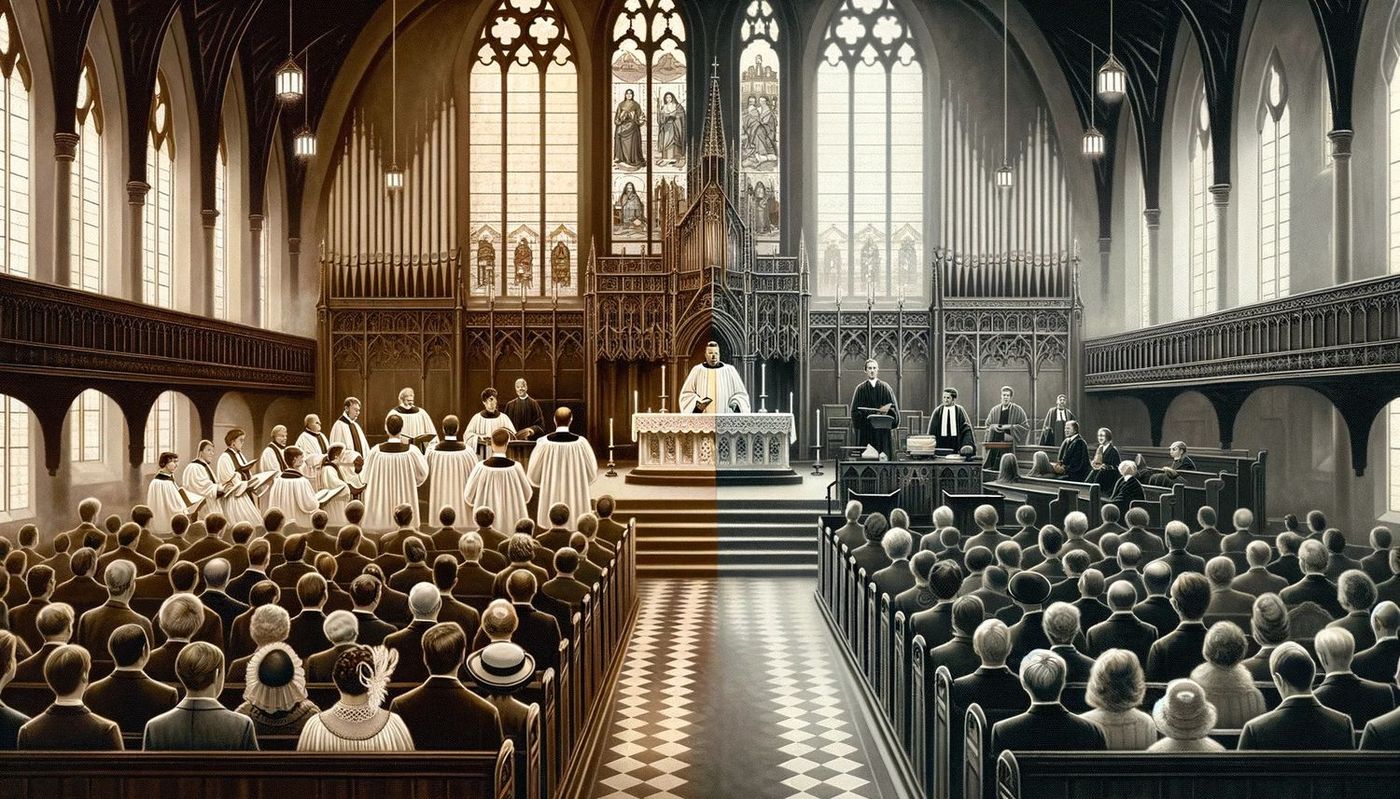Home>Theology and Spirituality>What Is The Difference Between A Baptist And A Southern Baptist


Theology and Spirituality
What Is The Difference Between A Baptist And A Southern Baptist
Published: February 23, 2024
Jason DeRose, Managing Editor at Christian.net, uses his expertise in religion and journalism to deepen understanding of faith's societal impacts. His editorial leadership, coupled with a strong academic background, enriches the platform’s diverse content, earning him recognition in both journalism and religious circles.
Discover the key distinctions between Baptist and Southern Baptist beliefs, practices, and traditions in this insightful exploration of theology and spirituality. Gain a deeper understanding of their unique perspectives and contributions.
(Many of the links in this article redirect to a specific reviewed product. Your purchase of these products through affiliate links helps to generate commission for Christian.net, at no extra cost. Learn more)
Table of Contents
Introduction
The Baptist and Southern Baptist denominations are two prominent branches of Protestant Christianity, each with its own distinct history, beliefs, and practices. While both groups share a common heritage and core theological principles, there are notable differences that set them apart. Understanding these differences can provide valuable insights into the diverse tapestry of Christian faith and practice.
Throughout history, the Baptist tradition has been characterized by its emphasis on individual freedom, congregational autonomy, and the priesthood of all believers. This tradition traces its roots to the 17th century, when dissenting English Puritans and Separatists sought to reform the Church of England. Their commitment to believer's baptism and the autonomy of local congregations became defining features of the Baptist movement.
In contrast, the Southern Baptist Convention emerged in the United States during the 19th century as a result of regional and theological divisions within the broader Baptist community. The Southern Baptist Convention's formation was influenced by factors such as slavery, the Civil War, and theological disagreements, leading to the establishment of a distinct Southern Baptist identity.
As we delve into the differences between the Baptist and Southern Baptist denominations, it is important to approach this exploration with an open mind and a spirit of curiosity. By gaining a deeper understanding of these traditions, we can appreciate the rich tapestry of Christian expression and the diverse ways in which individuals and communities seek to live out their faith.
History of Baptist and Southern Baptist
The history of the Baptist tradition can be traced back to the early 17th century in England, during a period of intense religious and political upheaval. Dissenting English Puritans and Separatists, disillusioned with the state-controlled Church of England, sought to establish a more authentic and biblically grounded form of Christian worship and community. This quest for religious purity and autonomy led to the emergence of the Baptist movement, characterized by its commitment to believer's baptism and the autonomy of local congregations.
The foundational principle of believer's baptism, which emphasizes the baptism of adult believers rather than infants, became a defining feature of the Baptist tradition. This practice symbolizes a personal commitment to faith and discipleship, reflecting the Baptist belief in the priesthood of all believers and the individual's direct relationship with God.
The Baptist movement quickly spread beyond England, finding fertile ground in the American colonies and other parts of the world. As the movement expanded, various Baptist associations and conventions were formed, reflecting diverse theological emphases and cultural contexts. This diversity gave rise to different Baptist groups, each with its own distinct identity and practices.
In the United States, the Southern Baptist Convention emerged as a separate entity in the 19th century, primarily due to regional and theological divisions within the broader Baptist community. Influenced by factors such as slavery, the Civil War, and theological disagreements, Southern Baptists sought to establish a distinct organizational structure and theological identity. The Southern Baptist Convention's formation marked a significant development in the history of Baptist denominations, as it represented a formalized expression of the unique theological and cultural perspectives prevalent in the southern states.
The Southern Baptist Convention's history is intertwined with the complex social and political dynamics of the American South, reflecting the region's distinctive cultural and religious landscape. Over time, the Southern Baptist Convention grew to become one of the largest Protestant denominations in the United States, exerting a significant influence on American religious life and societal issues.
Understanding the historical trajectories of the Baptist and Southern Baptist traditions provides valuable insights into the diverse and dynamic nature of Christian faith. These histories reflect the complex interplay of theological convictions, cultural contexts, and social dynamics, shaping the identities and practices of these influential denominations.
Beliefs and Practices of Baptist and Southern Baptist
The beliefs and practices of the Baptist and Southern Baptist denominations are rooted in their theological convictions, historical developments, and cultural contexts. While both groups share fundamental Christian beliefs, they exhibit distinct emphases and practices that shape their religious identities.
Baptist Beliefs and Practices
Baptists uphold the authority of the Bible as the primary source of faith and practice. They emphasize the priesthood of all believers, affirming the individual's direct access to God without the need for intermediaries. Believer's baptism, symbolizing personal faith and commitment, is a central practice among Baptists. This baptism is typically administered through immersion, reflecting the belief in the symbolic significance of immersion in water.
Congregational autonomy is a hallmark of Baptist polity, with local churches governing their affairs independently. This autonomy extends to matters of doctrine, worship, and church leadership, reflecting a commitment to individual freedom and the absence of hierarchical ecclesiastical structures.
Baptists prioritize evangelism and missions, seeking to share the Christian message and make disciples both locally and globally. This emphasis on spreading the gospel aligns with the Baptist belief in the Great Commission, viewing it as a mandate for all believers to engage in evangelistic efforts.
Southern Baptist Beliefs and Practices
Southern Baptists share many core beliefs with Baptists while also emphasizing distinctive theological and practical elements. The Southern Baptist Convention affirms the authority and inerrancy of the Bible, viewing it as the ultimate guide for faith and practice. Additionally, Southern Baptists hold to traditional Christian doctrines such as the Trinity, salvation by grace through faith, and the atoning work of Jesus Christ.
In terms of practices, Southern Baptists prioritize congregational worship, prayer, and the observance of the ordinances of baptism and the Lord's Supper. Baptism, similar to the Baptist tradition, is administered to believers by immersion, symbolizing the believer's identification with Christ's death, burial, and resurrection.
Southern Baptists place a strong emphasis on cooperative missions and evangelism, organizing collaborative efforts to support missionary work and outreach initiatives. The Southern Baptist Convention's cooperative program reflects a collective commitment to funding mission endeavors and supporting various ministries at local, national, and international levels.
Distinctive Emphases
While both Baptist and Southern Baptist traditions share foundational beliefs and practices, they exhibit distinctive emphases that reflect their historical and cultural contexts. Understanding these differences provides valuable insights into the diverse expressions of Christian faith and the multifaceted nature of religious identity within the broader Baptist family.
The beliefs and practices of the Baptist and Southern Baptist denominations reflect a dynamic interplay of theological convictions, historical legacies, and cultural influences, shaping the lived experiences of their adherents and communities. These distinct emphases contribute to the rich tapestry of Christian diversity, highlighting the multifaceted ways in which individuals and communities express their faith within the broader Baptist tradition.
Differences in Governance and Structure
The differences in governance and structure between the Baptist and Southern Baptist denominations reflect distinct approaches to organizational leadership, decision-making processes, and ecclesiastical authority. These variations have significant implications for the functioning of local churches, denominational entities, and the overall expression of religious identity within each tradition.
Baptist Governance and Structure
Baptist churches are characterized by congregational autonomy, wherein each local church exercises independent authority over its affairs. This decentralized model of governance empowers congregants to make decisions regarding matters such as doctrine, ministry initiatives, and the selection of church leaders. Congregational meetings serve as forums for members to participate in decision-making processes, reflecting the Baptist commitment to the priesthood of all believers and the democratic ethos within the church community.
The absence of a formal hierarchical structure distinguishes Baptist governance, as local churches operate autonomously without external ecclesiastical oversight. While Baptist associations and conventions exist for cooperative endeavors and mutual support, they do not hold authoritative control over individual congregations. This emphasis on local autonomy aligns with the Baptist belief in the freedom of conscience and the right of each church to discern and enact its own convictions.
Southern Baptist Governance and Structure
In contrast, the Southern Baptist Convention operates within a more centralized framework, featuring a hierarchical structure that includes local churches, associations, state conventions, and the national convention. This multi-tiered organizational system facilitates cooperative decision-making, resource allocation, and mission coordination across various levels of the denomination.
The Southern Baptist Convention exercises authority through elected representatives and administrative bodies, enabling collective decision-making on doctrinal, financial, and strategic matters. While local churches maintain a degree of autonomy, they voluntarily participate in the cooperative program and adhere to the doctrinal standards and mission initiatives established by the convention.
The hierarchical structure of the Southern Baptist Convention reflects a collaborative approach to governance, wherein shared leadership and coordinated efforts shape the direction and priorities of the denomination. This model fosters a sense of interconnectedness and collective responsibility among Southern Baptist churches, promoting unified action in mission endeavors and ministry outreach.
Implications and Significance
The differences in governance and structure between Baptist and Southern Baptist denominations have far-reaching implications for the exercise of authority, decision-making processes, and the cultivation of religious identity. These structural variations shape the dynamics of leadership, the distribution of ecclesiastical power, and the ways in which churches relate to broader denominational entities.
Understanding these distinctions provides valuable insights into the diverse organizational paradigms within the Baptist tradition, highlighting the multifaceted approaches to church governance and the complex interplay of autonomy and cooperation. These structural differences contribute to the rich tapestry of Baptist expressions, reflecting the diverse ways in which communities navigate questions of authority, leadership, and communal discernment within their respective denominational contexts.
Regional and Cultural Differences
Regional and cultural differences play a significant role in shaping the distinct identities and expressions of the Baptist and Southern Baptist denominations. These variations reflect the diverse historical, social, and geographical contexts in which these traditions have evolved, influencing their theological emphases, worship practices, and community dynamics.
Within the broader Baptist tradition, regional differences manifest in the unique cultural landscapes and historical legacies of different geographic areas. For example, Northern Baptists in the United States historically experienced distinct social and religious dynamics compared to their Southern counterparts. These regional disparities contributed to variations in theological emphases, social engagement, and approaches to issues such as racial justice and civil rights.
Similarly, cultural differences have influenced the worship styles, music traditions, and community dynamics within Baptist and Southern Baptist churches. The cultural tapestry of each region has shaped the ways in which congregations express their faith, engage in communal life, and navigate societal challenges. Whether through distinct musical traditions, worship practices, or community outreach initiatives, regional and cultural influences have left indelible marks on the lived experiences of Baptist and Southern Baptist communities.
The Southern Baptist Convention, in particular, reflects the cultural and historical context of the American South, encompassing a rich tapestry of traditions, customs, and social dynamics unique to the region. This distinctive cultural milieu has contributed to the formation of Southern Baptist identity, influencing doctrinal emphases, social attitudes, and approaches to mission and evangelism.
Moreover, regional and cultural differences have implications for the ways in which Baptist and Southern Baptist churches engage with societal issues, respond to cultural shifts, and embody their faith within diverse contexts. These differences enrich the broader Baptist tradition, showcasing the dynamic interplay between faith and culture and the multifaceted ways in which Christian communities express their beliefs within specific regional and cultural milieus.
In essence, regional and cultural differences within the Baptist and Southern Baptist denominations reflect the diverse tapestry of Christian expression, highlighting the dynamic interplay of faith, culture, and history. These differences contribute to the vibrancy and richness of the Baptist tradition, underscoring the multifaceted ways in which individuals and communities embody their faith within specific regional and cultural contexts.
Conclusion
In conclusion, the Baptist and Southern Baptist denominations embody rich and diverse expressions of Christian faith, shaped by their distinct historical trajectories, theological emphases, governance structures, and regional-cultural influences. While both traditions share fundamental theological convictions and a commitment to the authority of the Bible, they exhibit nuanced differences that reflect their unique identities and historical developments.
The history of the Baptist tradition traces back to the 17th century in England, characterized by a fervent pursuit of religious autonomy and a commitment to believer's baptism. This emphasis on individual freedom, congregational autonomy, and the priesthood of all believers has been foundational to the Baptist movement. In contrast, the Southern Baptist Convention emerged in the 19th century in the United States, reflecting regional and theological divisions within the broader Baptist community. Influenced by factors such as slavery, the Civil War, and theological disagreements, the Southern Baptist Convention established a distinct organizational structure and theological identity, particularly shaped by the cultural milieu of the American South.
The beliefs and practices of the Baptist and Southern Baptist denominations reflect their theological convictions and historical legacies. While both uphold the authority of the Bible and emphasize evangelism, they exhibit distinctive emphases in areas such as congregational autonomy, cooperative missions, and worship practices. These differences contribute to the rich tapestry of Christian diversity within the broader Baptist family, showcasing the multifaceted ways in which individuals and communities express their faith.
Furthermore, the differences in governance and structure between Baptist and Southern Baptist denominations have significant implications for the exercise of authority, decision-making processes, and the cultivation of religious identity. While Baptist churches operate with congregational autonomy, the Southern Baptist Convention features a more centralized framework, reflecting a collaborative approach to governance and mission coordination.
Regional and cultural differences also play a pivotal role in shaping the identities and expressions of the Baptist and Southern Baptist traditions. These variations reflect the diverse historical, social, and geographical contexts in which these traditions have evolved, influencing their theological emphases, worship practices, and community dynamics. The cultural tapestry of each region has left indelible marks on the lived experiences of Baptist and Southern Baptist communities, enriching the broader Baptist tradition with diverse expressions of faith and worship.
In essence, the Baptist and Southern Baptist denominations exemplify the dynamic interplay of faith, history, culture, and regional influences. By understanding and appreciating these differences, we gain valuable insights into the diverse tapestry of Christian expression and the multifaceted ways in which individuals and communities embody their faith within specific contexts. This exploration invites us to embrace the richness of Christian diversity and engage with a spirit of curiosity and respect for the varied expressions of faith within the broader Baptist tradition.













